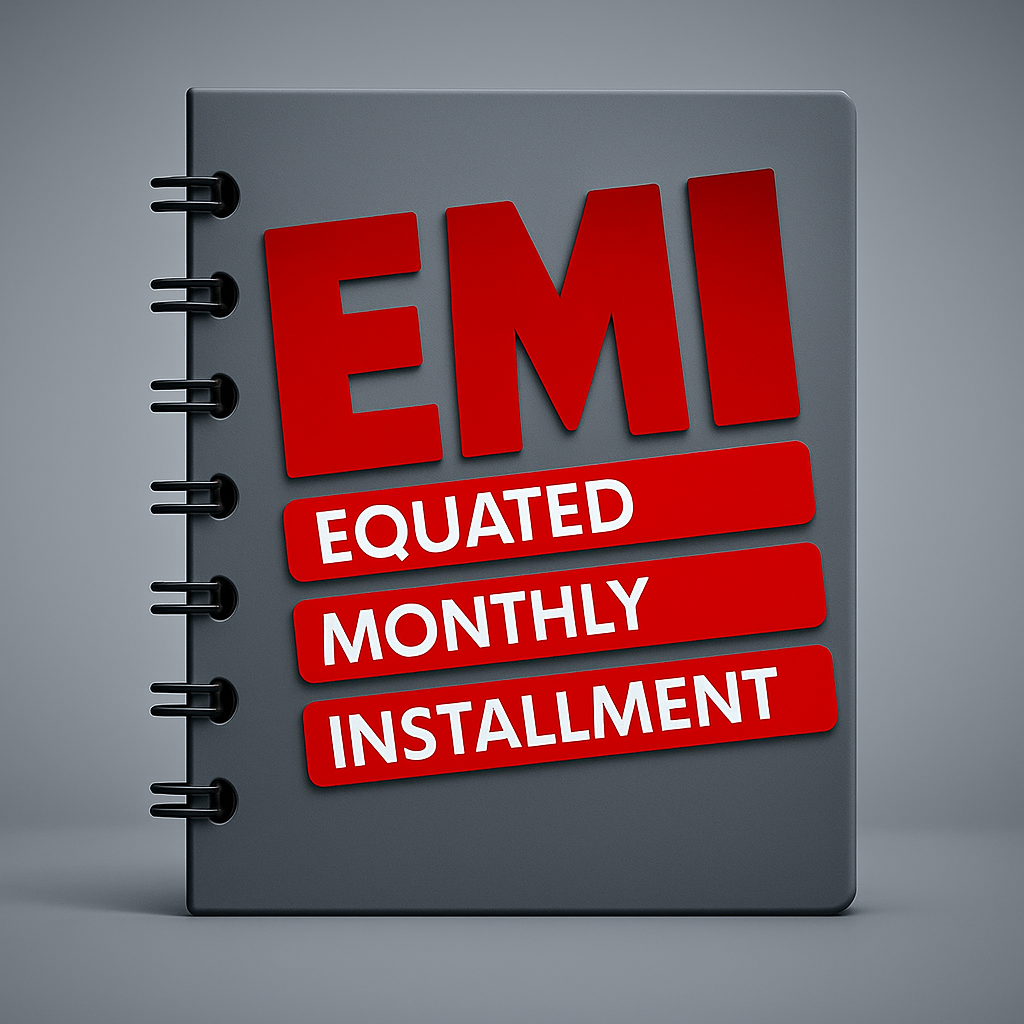
Complete Guide to Home Loans in India 2025
Everything you need to know about home loans, eligibility, documentation, and best practices.
Read More →
Simplify loan repayment with an accurate, easy-to-use EMI calculator that helps you make the right decisions quickly and easily.
Try Calculator NowEMI stands for Equated Monthly Installment, which is a fixed payment made at regular monthly intervals to repay an outstanding loan. When you borrow a certain amount from a financial institution at a specified interest rate, the repayment is typically made in monthly installments. The EMI amount is calculated based on the loan amount, interest rate, and tenure. By making periodic payments over a fixed term, the loan is fully repaid.
To settle the outstanding loan, the borrower must transfer a fixed amount to the lender each month on a predetermined date. Repayments can be made via cheque or online payment.
In EMI calculations, principal and interest are the two main components. During the initial period, a larger portion of the EMI goes toward interest, while a smaller portion reduces the principal. As the loan term progresses, the principal portion increases, and the interest decreases.
Every month, you are required to transfer a fixed EMI amount to the lender. Common payment methods:
Timely EMI payments help avoid penalties and protect your credit score.
EMIs make large expenses manageable and promote financial planning, credit building, and disciplined repayment. Compare loans, use calculators, and pick the best tenure and interest rate for your goals.

A loan is the money provided by a financial organization to an individual or business under a signed agreement, with a predefined interest rate and tenure. The EMI (Equated Monthly Installment) is the fixed monthly payment made by the borrower to the lender, which includes both principal and interest, over the agreed loan period.
EMIs have both benefits and drawbacks. The primary advantage is that they reduce the immediate cash burden when making large purchases. However, the drawbacks include interest charges and hidden processing fees. Overall, EMIs are a good option for individuals who cannot afford to pay a large amount upfront.
EMI is the amount you pay monthly to the lender for loan repayment. However, it may vary depending on the loan amount, tenure, and interest rate. Typically, when someone approaches a financial institution for a loan, these details are provided by the lender. The next step is to calculate the monthly installment, which can be done using a simple equation, as shown below.
EMI = Equated Monthly InstallmentP = Principal loan amountr = Monthly interest rate (annual interest rate ÷ 12 × 100)n = Loan tenure in monthsIf you borrow ₹1,00,000 at 10% annual interest for 12 months:
P = ₹1,00,000r = 10 ÷ (12 × 100) = 0.00833n = 12Insight: The EMI increases if the principal or interest rate increases. While a longer tenure reduces monthly EMI, it increases total interest paid. Plan smart to balance EMI affordability and long-term cost.
The principal amount is the total sum borrowed by an individual from the lender. It is usually determined based on the borrower's eligibility, creditworthiness, and the lender's approval criteria.
The interest rate is applied to the principal amount borrowed. There are various types of interest rates, including fixed rate, floating rate, and mixed rate.
Tenure is the total time period provided by the lender for loan repayment. Generally, shorter tenures result in lower total interest paid, but the monthly EMI will be higher.
A fixed interest rate remains unchanged for the entire loan tenure. Since the rate is constant, borrowers can easily predict their future payments, and the EMI remains the same throughout the loan period. Typically, fixed interest rates are 1–2% higher than floating rates, offering stability at a premium.
A floating or variable interest rate changes based on economic and market conditions. It is commonly used by credit card companies for unpaid balances. There are two scenarios:
A mixed interest rate combines both fixed and floating rates. It starts fixed for an initial period and later shifts to a floating rate. This gives initial stability and long-term flexibility.
Interest is calculated on the outstanding principal after each EMI. As the principal reduces, the interest component decreases—resulting in lower overall interest than flat rate methods.
Interest is calculated on the full loan amount for the entire tenure, regardless of repayments made. This method usually leads to a higher total interest paid.
Depending on the purpose, financial institutions offer various types of loans with different interest rates and repayment tenures. Below are some common loan types along with their respective EMI considerations:

A home loan is offered by a lending institution for purchasing a new house or flat, or for repairing, renovating, or extending an existing home. In India, borrowers can typically receive financing for 80%–90% of the property’s market value, with interest rates ranging from 6.5% to 12.00%. Lenders generally offer longer repayment tenures for home loans, often up to 25–30 years, depending on the institution.
Before approving the loan, the financial institution will conduct a due diligence check, including legal verification of the property. This helps protect borrowers from potential fraud or scams.

An education loan, also known as a student loan, is financial assistance provided by lending institutions to help students cover the cost of higher education. This loan scheme is designed for students with strong academic backgrounds who wish to pursue higher studies in India or abroad. It typically covers tuition fees, accommodation, and other related expenses.
The government-approved interest rate for education loans generally ranges from 8.0% to 16.0%, depending on various eligibility criteria. Repayment usually begins either 12 months after course completion or 6 months after securing a job — whichever comes first.

An auto loan, also known as a vehicle loan, is a secured loan offered by financial institutions to help individuals purchase two-wheelers or four-wheelers. The loan amount is determined based on the on-road price of the vehicle, and some lenders may offer up to 100% financing. Until the loan is fully repaid, the lender retains ownership of the vehicle (hypothecation).
The interest rate for vehicle loans typically starts from 8%, depending on the lender and the applicant’s credit profile. The repayment tenure usually ranges from 1 to 7 years.

A personal loan is an unsecured loan offered by lending institutions to help individuals meet various financial needs such as medical emergencies, vacations, debt consolidation, weddings, and more. It typically requires minimal documentation, and no collateral is needed.
The interest rate for personal loans is generally higher than that of secured loans, ranging from 8% to 24%, depending on the lender and the borrower's credit profile.

A business loan is typically an unsecured loan, meaning no collateral is required for approval. It can be availed to meet various financial needs of a startup or an existing business. Under different schemes, financial institutions may offer loans ranging from ₹50,000 to ₹40 crores, with interest rates ranging from 9% to 38%, depending on several factors such as creditworthiness, business profile, and lender policies.
Key benefits of business loans include minimal documentation, an overdraft facility, flexible tenure options, and top-up provisions for additional funding.

A loan against property (LAP) is a secured loan in which the borrower mortgages residential or commercial property to the lender as collateral. This type of loan can be used to cover both personal and business expenses. The lender retains legal rights over the property until the loan is fully repaid.
The interest rate for a loan against property typically starts at 8.15% and may vary depending on the borrower's profile and the lender’s criteria. Compared to unsecured loans, the interest rate for LAP is generally lower due to the reduced risk for the lender.
The primary eligibility criterion for a home loan is a credit score (typically above 550). Other factors include age, income, residential status, liabilities, and collateral availability.
Documents Required:Candidates aged 18–30 with a strong academic record and full-time enrollment at a recognized university are eligible.
Documents Required:Salaried/self-employed individuals over 21 with income > ₹3 lakhs can apply. Vehicle itself serves as collateral.
Documents Required:Indian citizens aged 21–60 with CIBIL score > 550 and minimum salary of ₹22,000 are eligible.
Documents Required:In India, unsecured business loans are available to self-employed professionals, non-professionals, and entities like private limited companies, partnerships, and LLPs. Lenders evaluate eligibility based on business experience, turnover, and a good CIBIL score (typically above 550).
Documents Required:Indian citizens aged 18 to 75 can apply for a loan against residential or commercial property. Approval depends on income, property verification, and value. Co-applicants may be added to improve eligibility.
Documents Required:
Everything you need to know about home loans, eligibility, documentation, and best practices.
Read More →
Smart strategies to lower your monthly EMI and save money on interest payments.
Read More →
Smart strategies to lower your monthly EMI and save money on interest payments.
Read More →
Smart strategies to lower your monthly EMI and save money on interest payments.
Read More →